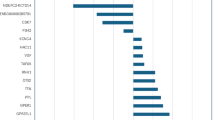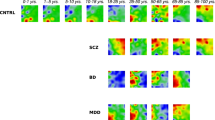Abstract
Through unbiased transcriptomics and multiple molecular tools, transient downregulation of the Orthodenticle homeobox 2 (OTX2) gene was recently causatively associated with the development of depressive-like behaviors in a mouse model of early life stress. The analyses presented in this manuscript test the translational applicability of these findings by examining peripheral markers of methylation of OTX2 and OTX2-regulated genes in relation to measures of depression and resting-state functional connectivity data collected as part of a larger study examining risk and resilience in maltreated children. The sample included 157 children between the ages of 8 and 15 years (χ = 11.4, SD = 1.9). DNA specimens were derived from saliva samples and processed using the Illumina 450 K beadchip. A subset of children (N = 47) with DNA specimens also had resting-state functional MRI data. After controlling for demographic factors, cell heterogeneity, and three principal components, maltreatment history and methylation in OTX2 significantly predicted depression in the children. In terms of the imaging data, increased OTX2 methylation was found to be associated with increased functional connectivity between the right vmPFC and bilateral regions of the medial frontal cortex and the cingulate, including the subcallosal gyrus, frontal pole, and paracingulate gyrus—key structures implicated in depression. Mouse models of early stress hold significant promise in helping to unravel the mechanisms by which child adversity confers risk for psychopathology, with data presented in this manuscript supporting a potential role for OTX2 and OTX2-related (e.g., WNT1, PAX6) genes in the pathophysiology of stress-related depressive disorders in children.
Similar content being viewed by others
Log in or create a free account to read this content
Gain free access to this article, as well as selected content from this journal and more on nature.com
or
References
Pena CJ, Kronman HG, Walker DM, Cates HM, Bagot RC, Purushothaman I, et al. Early life stress confers lifelong stress susceptibility in mice via ventral tegmental area OTX2. Science. 2017;356:1185–8. https://doi.org/10.1126/science.aan4491.
Maheu ME, Ressler KJ. Developmental pathway genes and neural plasticity underlying emotional learning and stress-related disorders. Learn Mem. 2017;24:492–501. https://doi.org/10.1101/lm.044271.116.
Jukic MM, Carrillo-Roa T, Bar M, Becker G, Jovanovic VM, Zega K, et al. Abnormal development of monoaminergic neurons is implicated in mood fluctuations and bipolar disorder. Neuropsychopharmacology. 2015;40:839–48. https://doi.org/10.1038/npp.2014.244.
Vernay B, Koch M, Vaccarino F, Briscoe J, Simeone A, Kageyama R, et al. Otx2 regulates subtype specification and neurogenesis in the midbrain. J Neurosci. 2005;25:4856–67.
Simeone A, Puelles E, Acampora D. The Otx family. Curr Opin Genet Dev. 2002;12:409–15.
Puelles E, Annino A, Tuorto F, Usiello A, Acampora D, Czerny T, et al. Otx2 regulates the extent, identity and fate of neuronal progenitor domains in the ventral midbrain. Development. 2004;131:2037–48.
Sugiyama S, Di Nardo AA, Aizawa S, Matsuo I, Volovitch M, Prochiantz A, et al. Experience-dependent transfer of Otx2 homeoprotein into the visual cortex activates postnatal plasticity. Cell. 2008;134:508–20. https://doi.org/10.1016/j.cell.2008.05.054.
Lee HHC, Bernard C, Ye Z, Acampora D, Simeone A, Prochiantz A, et al. Genetic Otx2 mis-localization delays critical period plasticity across brain regions. Mol Psychiatry. 2017;22:680–8. https://doi.org/10.1038/mp.2017.1.
Beurdeley M, Spatazza J, Lee HH, Sugiyama S, Bernard C, Di Nardo AA, et al. Otx2 binding to perineuronal nets persistently regulates plasticity in the mature visual cortex. J Neurosci. 2012;32:9429–37. https://doi.org/10.1523/JNEUROSCI.0394-12.2012.
Spatazza J, Lee HH, Di Nardo AA, Tibaldi L, Joliot A, Hensch TK, et al. Choroid-plexus-derived Otx2 homeoprotein constrains adult cortical plasticity. Cell Rep. 2013;3:1815–23. https://doi.org/10.1016/j.celrep.2013.05.014. Epub 2013 Jun 1813.
Kaufman J. Depressive disorders in maltreated children. J Am Acad Child Adolesc Psychiatry. 1991;30:257–65.
Kaufman J, Cicchetti D. The effects of maltreatment on school-aged children’s socio-emotional development: assessments in a day camp setting. Dev Psychol. 1989;25:516–24.
Kaufman J, Yang BZ, Douglas-Palumberi H, Houshyar S, Lipschitz D, Krystal J, et al. Social supports and serotonin transporter gene moderate depression in maltreated children. Proc Natl Acad Sci U S A. 2004;101:17316–21.
Bernstein D. A new screening measure for detecting ‘Hidden’ domestic violence. Psychiatr Times. 1998;15:448–53.
Pynoos, RS, Rodriguez, N, Steinberg, A. PTSD index for DSM-5. Los Angeles, CA: University of California Los Angeles; 2013.
Kaufman J, Jones B, Steiglitz E, Vitulano L, Mannarino A. The Use of Multiple Informants to Assess Children's Maltreatment Experiences. Journal of Family Violence. 1994;9:227–48.
Holbrook, H, et al. The Yale-Vermont Adversity in Childhood Scale: A Quantitative Approach to Adversity Assessment. In: American Academy of Child and Adolescent Psychiatry’s 61st Annual Meeting. San Diego, CA; 2015.
Angold A, Costello EJ, Messer S, Pickles A, Winder F, Silver D. Development of a Short Questionnaire for use in Epidemiological Studies of Depression in Children and Adolescents. International Journal of Methods in Psychiatric Research. 1995;5:237–49.
Aryee MJ, Jaffe AE, Corrada-Bravo H, Ladd-Acosta C, A.P. F, Hansen KD, Irizarry RA. Minfi: A flexible and comprehensive Bioconductor package for the analysis of Infinium DNA Methylation microarrays. . Bioinformatics. 2014;30:363–1369.
Wood AR, Esko T, Yang J, Vedantam S, Pers TH, Gustafsson S, et al. Defining the role of common variation in the genomic and biological architecture of adult human height. Nat Genet. 2014;46:1173–86. https://doi.org/10.1038/ng.3097.
Danese A, Tan M. Childhood maltreatment and obesity: systematic review and meta-analysis. Mol Psychiatry. 2014;19:544–54.
Yang B-Z, Zhang H, Ge W, Weder N, Douglas-Palumberi H, Perepletchikova F, et al. Child Abuse and Epigenetic Mechanisms of Disease Risk. American Journal of Preventive Medicine. 2013;44:101–7.
Houseman EA, Accomando WP, Koestler DC, Christensen BC, Marsit CJ, Nelson HH, et al. DNA methylation arrays as surrogate measures of cell mixture distribution. BMC Bioinformatics. 2012;13:86. https://doi.org/10.1186/1471-2105-13-86.
Smith AK, Kilaru V, Klengel T, Mercer KB, Bradley B, Conneely KN, et al. DNA extracted from saliva for methylation studies of psychiatric traits: evidence tissue specificity and relatedness to brain. Am J Med Genet B Neuropsychiatr Genet. 2015;168B:36-44. https://doi.org/10.1002/ajmg.b.32278.
Adkins RM, Krushkal J, Tylavsky FA, Thomas F. Racial differences in gene-specific DNA methylation levels are present at birth. Birth Defects Res A Clin Mol Teratol. 2011;91:728–36. https://doi.org/10.1002/bdra.20770.
Heyn H, Moran S, Hernando-Herraez I, Sayols S, Gomez A, Sandoval J, et al. DNA methylation contributes to natural human variation. Genome Res. 2013;23:1363–72. https://doi.org/10.1101/gr.154187.112.
Barfield RT, Almli LM, Kilaru V, Smith AK, Mercer KB, Duncan R, et al. Accounting for population stratification in DNA methylation studies. Genet Epidemiol. 2014;38:231–41. https://doi.org/10.1002/gepi.21789.
Du P, Zhang X, Huang C, Jafari N, Kibbe W, Hou L, et al. Comparison of Beta-value and M-value methods for quantifying methylation levels by microarray analysis. BMC Bioinformatics. 2010;11:587.
Soumiya H, Fukumitsu H, Furukawa S. Prenatal immune challenge compromises the normal course of neurogenesis during development of the mouse cerebral cortex. J Neurosci Res. 2011;89:1575–85. https://doi.org/10.1002/jnr.22704.
De Chevigny A, Core N, Follert P, Wild S, Bosio A, Yoshikawa K, et al. Dynamic expression of the pro-dopaminergic transcription factors Pax6 and Dlx2 during postnatal olfactory bulb neurogenesis. Front Cell Neurosci. 2012;6:6. https://doi.org/10.3389/fncel.2012.00006.
Prakash N, Brodski C, Naserke T, Puelles E, Gogoi R, Hall A, et al. A Wnt1-regulated genetic network controls the identity and fate of midbrain-dopaminergic progenitors in vivo. Development. 2006;133:89-98.
Riva-Posse P, Choi KS, Holtzheimer PE, Crowell AL, Garlow SJ, Rajendra JK, et al. A connectomic approach for subcallosal cingulate deep brain stimulation surgery: prospective targeting in treatment-resistant depression. Mol Psychiatry. 2017;11:59.
Akil H, Gordon J, Hen R, Javitch J, Mayberg H, McEwen B, et al. Treatment resistant depression: A multi-scale, systems biology approach. Neurosci Biobehav Rev. 2018;84:272–88.
Mayberg HS, Brannan SK, Mahurin RK, Jerabek PA, Brickman JS, Tekell JL, et al. Cingulate function in depression: a potential predictor of treatment response [see comments]. Neuroreport. 1997;8:1057–61.
Ducharme S, Albaugh MD, Hudziak JJ, Botteron KN, Nguyen TV, Truong C, et al. Anxious/Depressed Symptoms are Linked to Right Ventromedial Prefrontal Cortical Thickness Maturation in Healthy Children and Young Adults. Cereb Cortex. 2014;24:2941–50. Epub 2013 Jun 2907 https://doi.org/10.1093/cercor/bht151.
Dichter GS, Felder JN, Smoski MJ. The effects of brief behavioral activation therapy for depression on cognitive control in affective contexts: an fMRI investigation. J Affect Disord. 2010;126:236–44. https://doi.org/10.1016/j.jad.2010.03.022.
Kaufman, J., Unraveling the Genetics of Major Depression and Stress-Related Psychiatric Disorders: Is it Time for a Paradigm Shift? Biological Psychiatry, 2018. 84(2): p. 82–4
Acknowledgements
We thank the children and families who participated in this research and the administration of the Vermont Department of Children and Families for their collaboration on this effort. This work was supported by the Zanvyl and Isabelle Krieger Fund (JK), the NIH R01MH098073 (JK, JH), R01 MD011746-01 (JK); the National Center for Posttraumatic Stress Disorder—Veterans Affairs, Connecticut (JG, JK); the VA Cooperative Study #575B, Genomics of Posttraumatic Stress Disorder in Veterans (JG, JK); and the Biological Sciences Training Program through 5T32 MH14276 (JLM-O).
Author information
Authors and Affiliations
Corresponding author
Ethics declarations
Competing interests
The authors declare no competing interests.
Additional information
Publisher's note: Springer Nature remains neutral with regard to jurisdictional claims in published maps and institutional affiliations.
Electronic supplementary material
Rights and permissions
About this article
Cite this article
Kaufman, J., Wymbs, N.F., Montalvo-Ortiz, J.L. et al. Methylation in OTX2 and related genes, maltreatment, and depression in children. Neuropsychopharmacol 43, 2204–2211 (2018). https://doi.org/10.1038/s41386-018-0157-y
Received:
Revised:
Accepted:
Published:
Issue date:
DOI: https://doi.org/10.1038/s41386-018-0157-y
This article is cited by
-
SDFA: a standardized decomposition format and toolkit for efficient analysis of structural variants in large-scale population genomic studies
Genome Biology (2025)
-
Overexpression of OTX2 in human neural cells links depression risk genes
Translational Psychiatry (2025)
-
Neurobiology of resilience to early life stress
Neuropsychopharmacology (2025)
-
Dissecting early life stress-induced adolescent depression through epigenomic approach
Molecular Psychiatry (2023)
-
Biomarkers in Child and Adolescent Depression
Child Psychiatry & Human Development (2023)



